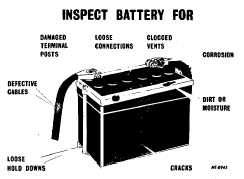|
| |
TRUCK SERVICE MANUAL
TM 5-4210-230-14&P-1
TABLE 2
Specific
State of
Freezing
Gravity
Charge
Point
1.265
100%
-59.50 C (-75° F)
1.225
75%
-37.2° C (-35° F)
1.190
50%
-26.10 C (-15° F)
1.155
25%
-15.00 C ( +5° F)
1.120
Discharged
-9.40 C (+15° F)
Batteries must be kept fully charged when batteries or
vehicles are stored in sub-freezing temperatures.
TEMPERATURE AFFECTS BATTERY OUTPUT
CAPACITY (CRANKING POWER)
Battery temperature affects the output capacity of a battery
with respect to cranking an engine. The cranking power of the
battery is reduced as battery temperature is lowered.
Table 3 lists the approximate percentage of output capacity of
a fully charged battery at various temperatures.
Note that a fully charged battery at -17.8° C (0° F) gives only
40 percent of its cranking power at 26.7° C (80° F).
TABLE 3
Temperature
Percentage of Battery
Capacity
(Fully Charged)
26.7 C (80 F)
100%
0 C (32 F)
65%
-17.8° C ( 0° F)
40%
-28.8 C (-20°
F)
20%
Batteries at less than the fully charged
state will provide even less of their output
capacity. This emphasizes the importance
of keeping vehicle batteries fully charged
when low temperatures will be
encountered.
MAINTENANCE (IN VEHICLE)
The battery is a perishable item and requires attention. With
a reasonable amount of care the life of a battery can be
appreciably extended. Neglect and abuse will invariably
cause shorter battery service life.
The battery should be inspected at the time of chassis
lubrication or other periodic services.
Battery maintenance includes the following:
1. Inspect battery and mounting for defective cables, loose
connections, loose or damaged hold down parts, damaged
terminal posts or studs, clogged vents, cracked, or
distorted battery case or cover, and accumulations of dirt,
moisture and corrosion (Figure 8). Replace any damaged
parts.
Fig. 8 Battery Maintenance Inspection
2. If corrosion is found on the terminal posts, remove the
cable terminals from the battery (ground cable first) using
the proper end wrench and a cable puller. A terminal
cleaning brush can be used to clean tapered posts and
the mating surfaces of the cable clamps. Other type
terminals can be cleaned with a wire brush. The cable
terminals should then be cleaned with an acid neutralizing
solution of baking soda and water. Clean dirt from the
battery top with a cloth wetted with baking soda and
water. Then wipe with a cloth with clear water. A wire
brush can be used to remove dirt, corrosion or rust from
the battery tray or hold down parts.
After rust is removed, rinse with clear water dry with air
and repaint.
CTS-2771 Page 8
PRINTED IN UNITED STATES OF AMERICA
|

